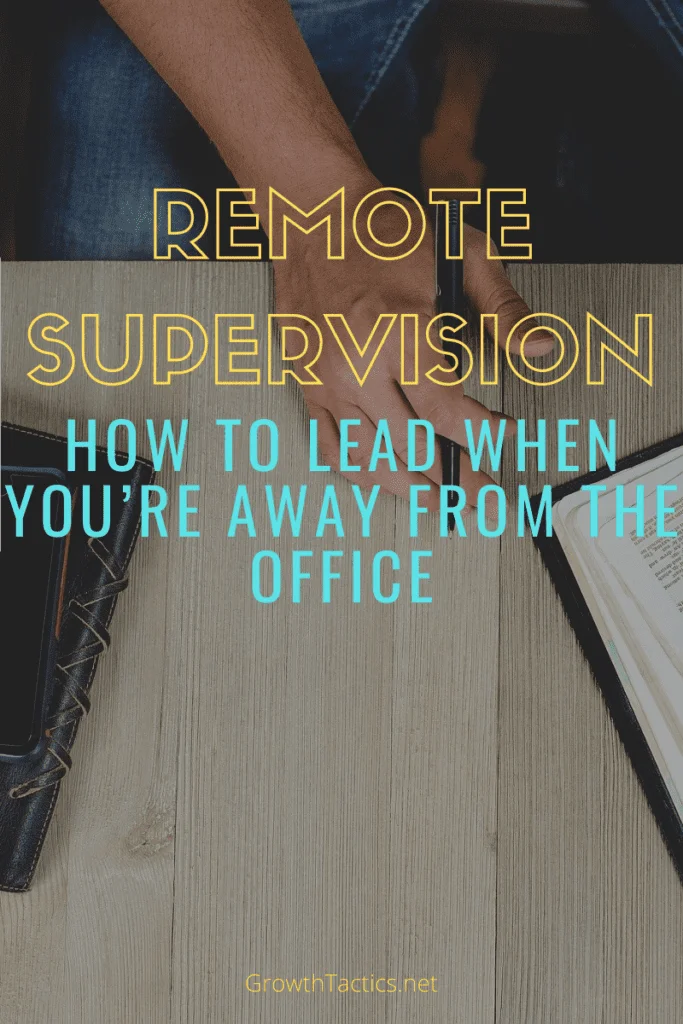Can your team run efficiently even when you’re gone? As a supervisor, it is important to lead when away from the office or utilize strong remote leadership skills. Managing a remote team is a skill all leaders need to have. Especially in this day and age where remote workers are a very common occurrence. Not to mention all the teleworking that has opened up since the recent pandemic.
For many supervisors, it can be very scary to be out of the office for any amount of time even if you are going to do remote work. Some believe everything will fall apart but just because you are away from the office it doesn’t mean you can’t still be a leader for your team. There are many ways you can still ensure your team is a success while you are away.
Jump To Section
Challenges and Rewards of Remote Management
Managing a remote team has its advantages and disadvantages. While the flexibility, productivity, cost savings, diversity, and environmental benefits that come with remote work are undeniable, communication, coordination, technology, distractions, and isolation can be major challenges for remote managers.
Communication is a critical issue for remote teams because building relationships and establishing trust without face-to-face interaction can be difficult. Coordinating work across different time zones and locations can also be challenging, making it hard to ensure that everyone is working towards the same goals. Technical issues such as poor internet connections and outdated software can also slow down work and lead to frustration.
Remote workers can also struggle with distractions and feelings of isolation, making it challenging to stay focused and engaged. However, the flexibility offered by remote work can lead to improved work-life balance, increased productivity, and cost savings for both employers and employees.
Additionally, remote work opens up opportunities to hire the best talent worldwide, regardless of location. Finally, by reducing carbon emissions from commuting and office energy use, remote work can have a positive impact on the environment.
By addressing the communication, coordination, technology, distraction, and isolation challenges that come with remote management and leveraging the rewards of remote work, organizations can create a successful remote work culture that benefits both employees and the business.
Tips to Be a Great Remote Manager
Being a remote leader or leading a remote team can present some challenges but the tips below will help you keep productivity and effectiveness high.
1. Keep the lines of communication open.

If you work remotely, one of the most important things is communication. This is vital for success whether you are in the office or not. When you are out of the office it’s even more vital to have good communication with your employees.
You aren’t there to experience everything going on so the only way to stay in the loop is by utilizing good communication with your team. Good communication is the key to successfully manage remote teams.
2. Understand what type of employees you have.
Virtual leaders need to understand their employees’ types. The type of employees you have working for you determines how much oversight you need to have in these situations. If you have self-starters, you can be a little more hands-off and let your employees do their job.
If you have inexperienced employees that need more direction, you need to be more involved, giving more precise direction. Being too involved with or not involved enough with your team can hurt progress and production so it’s important to know your employees.
3. Stay in the loop.
To lead in your work center, you must know what’s going on in your work center and with your team. This is where communication plays a huge role.
You can’t help if you don’t know what’s going on.
Make it a priority to get updates on how everything is going and what issues your team is facing. You may even be able to help with a lot of the issues your employees are facing even though you are out of the office. Staying in the loop is crucial to expertly lead when away from the office
4. Check on your team.
Make it a priority not only to check in on the work area but also on your team. Members of your team could be having issues that may not be affecting the work yet, but it could lead to something bigger if not addressed.
Many times, when the leader is out of the office, there may be a void. Is someone else filling this leadership void? If you did not select this person and make it clear to the team that this person was in charge while you were gone, it can cause turmoil in the team. You have to make sure your team still works like a team in your absence.
Checking in on your team the right way will help build trust with them so that you can fill your role as a successful remote manager.
5. Utilize the technology available to you.

In our world, there are many forms of technology available to help you stay in contact with your team. You can have your emails forwarded to your phone if your job requires you to stay on top of your emails.
You can use group messaging apps to help contact multiple members of your team at the same time. Video chat is a great way to get that in-person conversation with your team members even though you are not in the office. Technology can be great for helping us keep in contact when we are not able to be there in person. It can be a great tool to lead when away from the office
For 8 awesome team management apps check out this link click here.
6. Include your team in decisions as much as possible.
You should always try to include your team members in decision-making to the most extent possible. This helps give them ownership of the decision and makes it more likely that they will try to make it a success.
This can be extra important when you can’t be at the office. Sometimes your employees will have more information on the situation in the work area and they may see some things that you are missing since you are not there. To successfully lead when away from the office, you will need your team.
7. Remember that you are not there.
It’s important to remember that you are not there. Things will probably not run the same as if you were there but that may not always be a bad thing. Empower your employees and they might surprise you.
Even when you are there it’s hard to know every detail of everything that is going on. When you are not in the office, you will miss even more.
Leaning on your trusted employees for information and guidance can be extra important. If you try to lead like you are in the office, you run the risk of damaging the relationships with your team and making a lot of bad calls because you don’t have all the information.
8. Be available but set boundaries.

Being available for your team when they need you is very important, but you also need to have boundaries. If you know you are not going to be available during certain hours, let your team know.
If you don’t want to get calls all day long about every little detail, let your employees know early that they should send emails for things that aren’t urgent and texts if it’s something more urgent but doesn’t require a lot of discussion. Many times, employees may not know if it is acceptable to text because it may not always seem professional, but text messaging can be very efficient.
9. Clarify your tone during conversations.
When it comes to remote leadership, most if not all conversations will be done with means other than face-to-face. Text messaging and emails can be very impersonal, and your tone can be very confusing for your employees. Even conversations over the phone can be misunderstood.
Your employees may sometimes think things are more urgent or less urgent than you anticipated them to be in your message. It’s vital that you clarify and are very specific in your messages. If you aren’t specific priorities can get confusing for your team and your real message could be misunderstood.
10. Be clear about your expectations.
Make sure your expectations of your team are clear and understood by all employees while you are gone. Clear expectations will help ensure your employees aren’t veering off the tracks while you are away and help with autonomy in many cases.
You want to do this before you are away or as soon as possible after you leave. Then reevaluate your expectations as time goes on. Expectations are vital to successfully lead when away from the office.
11. Find a way to still take care of your employees.

Just like when you are present, you need to find a way to fill your employees’ needs and eliminate roadblocks. This means you may have to make some phone calls to get something your team needs to do their job. If available have another supervisor from another department check up on your team to make sure they don’t need anything.
You should also make it a priority to ask them if they need anything whenever you contact them and make sure they know they can call or text you if they need anything. Don’t let your employees’ needs go unfilled just because you are not there.
12. If you are not going to be available, your staff needs to have somebody to go to.
Even if you can’t work from home, have someone on your team fill your role while you are gone. If that’s not an option, ensure there is a supervisor from another area who can help your team out when they need it.
No matter who you have filling your role, make sure everyone knows who is in charge. If you don’t make it known to everybody it can cause unnecessary turmoil and stress on the team.
Tools for Remote Management
As remote work becomes increasingly popular, the need for effective remote management tools has never been greater. Here are some of the best tools for remote management:
- Slack: This popular messaging app allows remote teams to communicate in real time, share files, and collaborate on projects.
- Zoom: Video conferencing is a critical component of remote work, and Zoom is one of the most popular tools for hosting virtual team meetings and webinars in a remote environment.
- Trello: Trello is a project management tool that allows remote teams to organize tasks, assign responsibilities, and track progress in real-time.
- Google Drive: Google Drive is a cloud-based storage platform that allows remote teams to share and collaborate on documents, spreadsheets, and presentations.
- Asana: Asana is a project management tool that helps remote employees stay organized and on track with their work.
- Basecamp: Basecamp is an all-in-one project management tool that includes features such as to-do lists, schedules, and file sharing.
- Monday.com: Monday.com is a team management tool that allows remote teams to track projects, assign tasks, and collaborate in real time.
- Todoist: Todoist is a task management tool that helps remote teams stay on top of deadlines and prioritize their work.
- GitHub: GitHub is a platform for software development teams that allows them to collaborate on code, track changes, and manage projects.
- Hootsuite: Hootsuite is a social media management tool that allows remote teams to manage multiple social media accounts, schedule posts, and track engagement.
These are just a few of the many tools available for remote management. The key is to find the tools that work best for your team and your specific needs.
Bottom Line on Managing a Remote Workforce
The bottom line is that you are still the leader of your team even if you are not there or if you have a virtual team. It may take a little extra work to keep up with what is going on while you’re away from the office but it’s worth it in the long run. It’s your job as a leader to continue to add value to your team and still lead when away from the office.
Check out this article from Forbes if you want more information on how to lead when away.
If you found this article useful on how to be a great remote manager and how to lead when you’re away from the office, please don’t forget to share using the buttons below.


